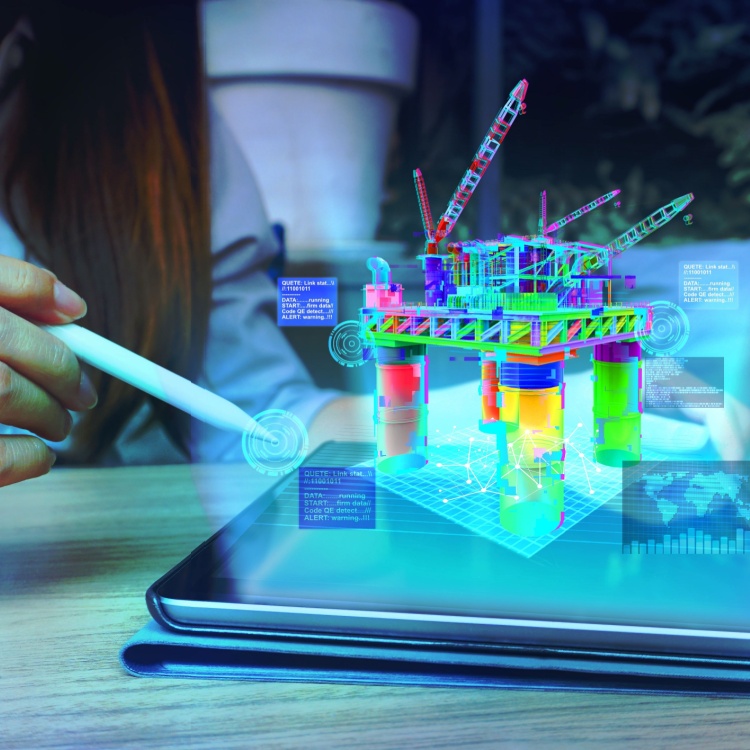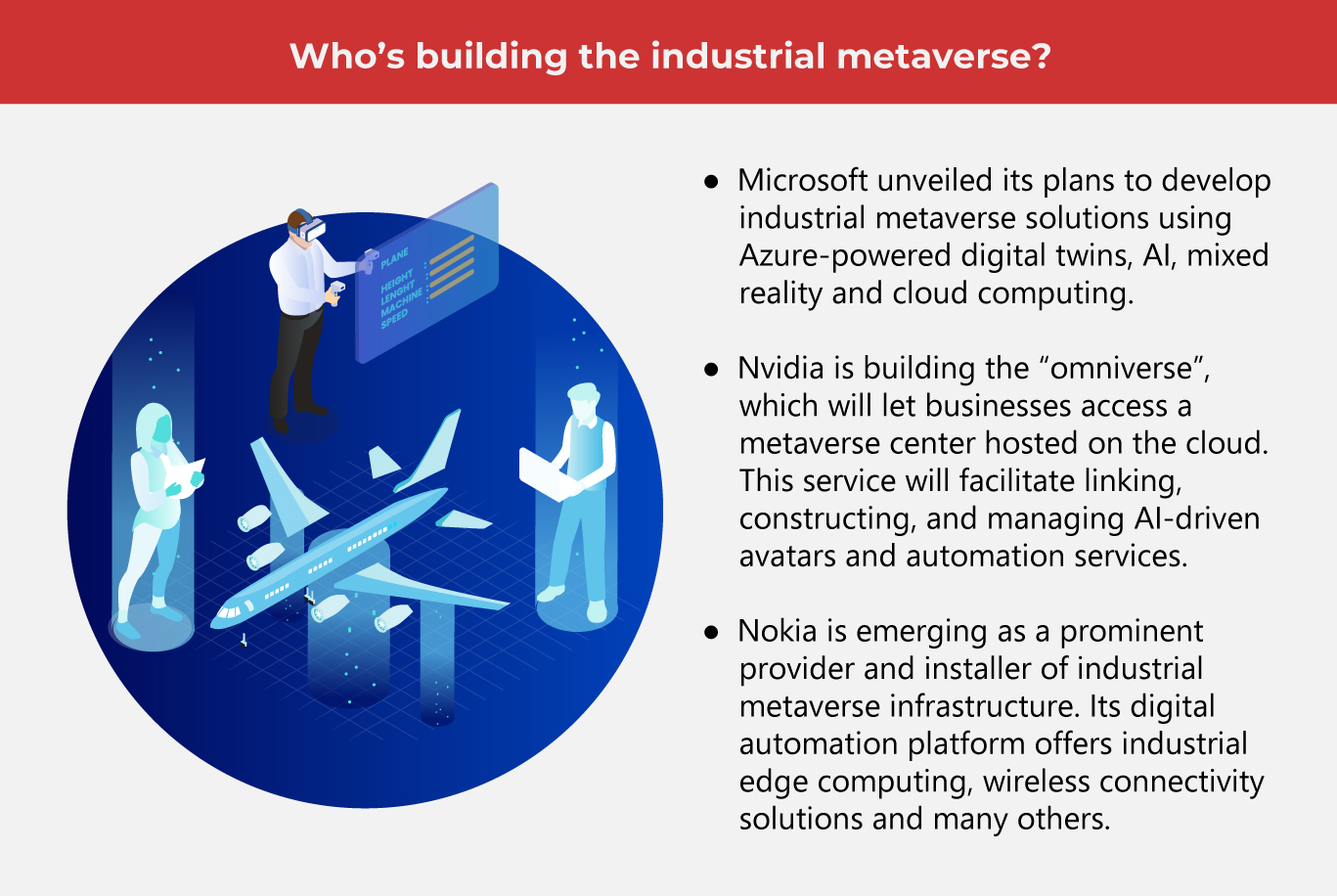Welcome to the Exciting Word of the Industrial Metaverse

The term "metaverse" has recently been a hot topic in tech news, attracting praise and criticism from major industry players. But what is the metaverse, and how does it impact the industrial environment?
2020 marked the beginning of the COVID-19 pandemic, which threatened to halt Siemens from building its new 70,000-square-meter manufacturing facility in Beijing. To continue the project, the global manufacturing giant meticulously planned its development using digital tools. This gave birth to the company's first digital native factory, which leverages technologies like the Internet of Things (IoT), digital twins, and artificial intelligence (AI) to optimize production. As a result, productivity saw a 20% boost, volume flexibility enhanced by 30%, and replenishment speed surged by 50% compared to the previous plants and production designs.
An industrial metaverse study revealed that 92% of surveyed top management are presently leveraging metaverse technologies. While 33% of firms implement 3D design software and digital twins, 20% use virtual factories.
Their main reason for going digital is to enhance manufacturing production. However, businesses also use the metaverse to develop human resources tools, such as virtual plan tours and immersive training sessions. These technologies also assist in supply chain coordination, logistics, and customer-oriented frameworks.
According to the study, over 70% of those surveyed predict an increased adoption of metaverse technologies within industrial firms over the next five years.
What is the industrial metaverse?
The metaverse is made up of various applications and tools that aim to improve efficiency and workflows across industries. A diverse array of technologies combine to generate an immersive three-dimensional virtual environment or a hybrid virtual and physical industrial setting. Although the industrial metaverse is still in its infancy, its ultimate objective is to foster real-time collaboration and geospatial awareness within industrial settings.
Numerous specialists regard the industrial metaverse as the next stage of Industry 4.0, which involves integrating advanced technologies. Industrial metaverse components typically include:
- A hardware setup that comprises connectivity and computational abilities
- Software infrastructure that includes AI, development, programming tools, and distributed ledger technologies like blockchain
- Industrial networks with robotics, sensors ,and IoT
These technologies collectively form the groundwork for an industrial metaverse platform.
Top 8 benefits of using the industrial metaverse
Cutting-edge technologies converge in the industrial metaverse to redefine the business operations landscape. Learn how this development can maximize productivity and returns in the industrial environment.
-
Boosted efficiency
An industrial metaverse allows remote specialists to better understand the movement patterns of workers, products, and machinery within an area. Using spatial analytics, they can study the gathered data and propose ways to enhance performance and pinpoint inefficiencies. Like what Siemens did, experts can work together to design a layout that optimizes equipment and increases savings. It's faster to plan designs digitally, thanks to streamlined workflows and effective feedback loops. When space is efficiently designed, it improves worker safety and mobility, thereby boosting overall productivity.
-
Improved employee performance
Virtual reality (VR) and augmented reality (AR) can provide employees with immersive training scenarios. These scenarios let them complete tasks hands-on but in a safe and controlled environment. Because employees have access to real-time data from the industrial metaverse, they can better understand complex processes. Visual representations of data let them make informed decisions and solve problems. Automation can also streamline operations, with robotics taking on repetitive tasks and freeing employees to focus on higher-level responsibilities.
-
Experimentation with innovation
Product design and development is easier and faster when you have a virtual environment for experimentation. You can test new ideas with digital twins of real-life systems while reducing risks. Physical product testing racks up costs, which include the venue, actual prototypes, certification, and labor. In an industrial metaverse, worker safety is ensured in a setting that still provides collaboration, real-time analytics, and practical training. This reduces costs and accelerates the development of innovative solutions.
-
Labor solutions
A virtual setup can access global talent, which helps address labor shortages. Employers like you are no longer limited by finding employees within their company's vicinity. This opens up a more extensive and diverse talent pool, fostering innovation and creativity. It also lets you find specialized expertise that may be locally scarce. This flexibility enables you to scale teams up or down based on project needs, minus the geographical concerns.
-
Remote work
Because remote workers mean you can connect with them virtually, anywhere they are in the world, you don't have to build a physical workspace. This lets you save on expenses like office rent, utilities, and maintenance. You also cut down on expensive travel for meetings and evaluations. Cost savings improve overall profitability and make funding for other business areas possible. Additionally, job flexibility improves productivity and work-life balance– essential components of employee retention.
-
Easier troubleshooting
Technologies like IoT and digital twins enable real-time visualization and predictive maintenance. This works through sensors collecting real-time data from equipment, helping systems forecast failures before they happen. Meanwhile, AR and VR provide immersive experiences that let experts troubleshoot or guide assistants even from remote locations. Thanks to AI and machine learning, diagnostics can be automated, which helps pinpoint the root causes of problems faster and more easily. These systems can also recommend and implement solutions to accelerate the troubleshooting process.
-
Better collaboration
Remote teams can collaborate in real-time, while complex data visualization ensures everyone is on the same page. Clear communication is an important component of joint problem-solving and the decision-making process. Integrated communication platforms streamline information sharing, while knowledge sharing across departments and generations is possible through extensive databases hosted by the metaverse. Finally, virtual training sessions that promote collaboration effectively prepare all team members, resulting in better coordination and results.
-
Reduced environmental impact
Because the industrial metaverse streamlines operations, unnecessary steps are eliminated, which helps lower energy consumption. AI and data analytics can also control systems and machinery to optimize energy usage. To improve environmental responsibility, the metaverse can harness renewable energy and smart grid technologies. With a smaller environmental footprint, industries can achieve their business goals with fewer resources, promoting long-term sustainable development.
The industrial metaverse is undoubtedly the next step for businesses, but it currently grapples with challenges, including costs, competent talent, and cybersecurity risks. As technologies become more connected, data security issues arise.
But if these difficulties are overcome, leveraging the metaverse can vastly improve processes, enhancing products and services. Ultimately, it's about bridging the gap between the physical and digital, equipping industries with the necessary tools for success. As one of the Top 20 EMS companies in the world, IMI has over 40 years of experience in providing electronics manufacturing and technology solutions.
As one of the Top 20 EMS companies in the world, IMI has over 40 years of experience in providing electronics manufacturing and technology solutions.
We are ready to support your business on a global scale.
Our proven technical expertise, worldwide reach, and vast experience in high-growth and emerging markets make us the ideal global manufacturing solutions partner.
Let's work together to build our future today.
Other Blog



